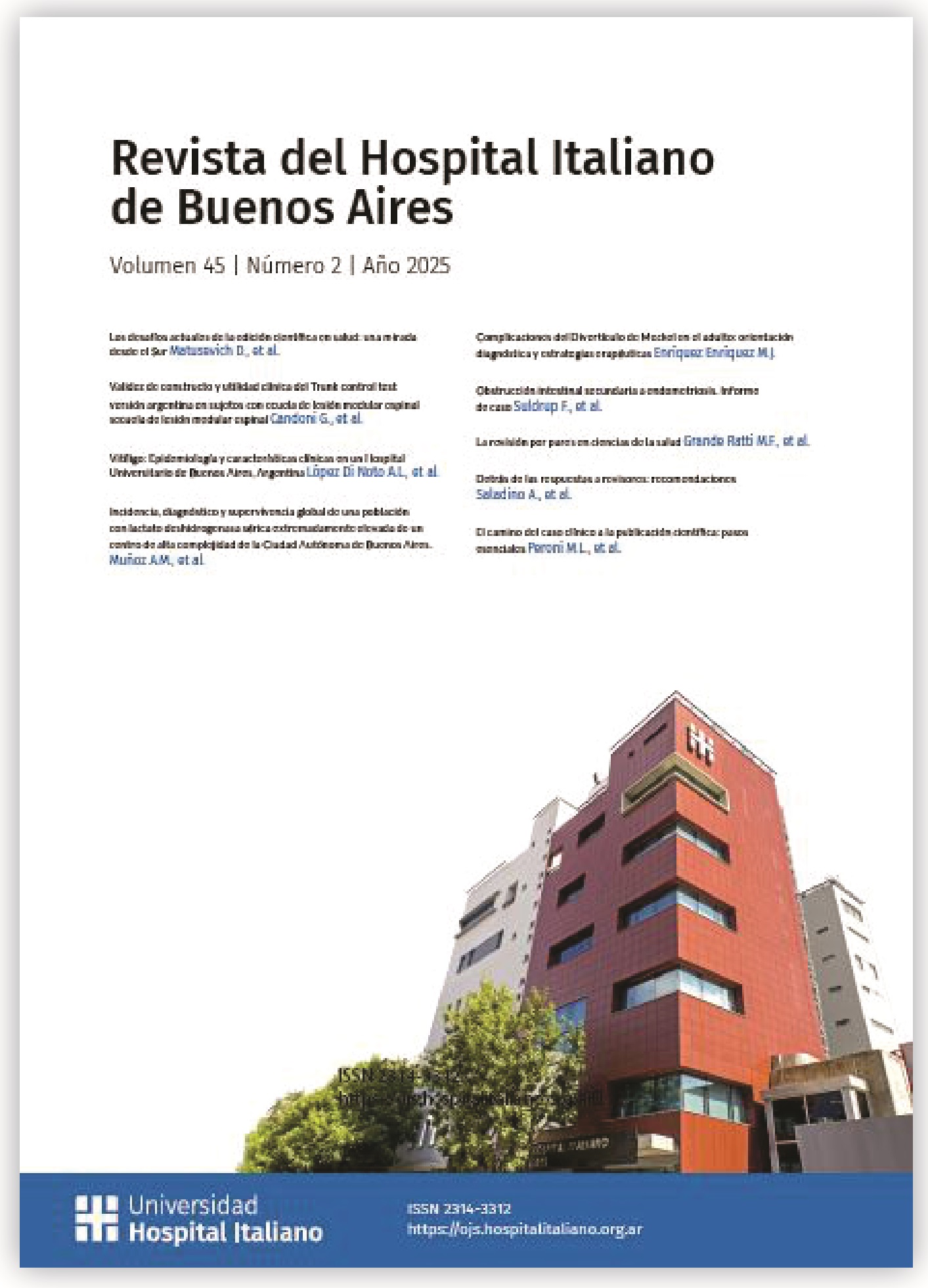Construct Validity and Clinical Utility of the Argentine Version of The Trunk Control Test in Subjects With Spinal Cord Injury Sequelae ne version of the trunk control test in subjects with sequelae of spinal cord injury
Main Article Content
Abstract
Introduction: Individuals with adequate trunk control have a greater likelihood of independently performing activities of daily living, regardless of the level or severity of their injury. However, there are currently no valid and reliable tools in Argentina to assess trunk control in this population. This study aimed to determine the construct validity and clinical utility of the Argentine version of the Trunk Control Test (TCT).
Materials and Methods: Participants were enrolled through non-probabilistic convenience sampling until the target sample size was reached or up to two years after approval. The required sample size was 50 participants. Inclusion criteria were: individuals aged 15 to 75 years with a diagnosis of spinal cord injury. Exclusion criteria included: other neurological diagnoses, sensory organ impairments, conditions preventing test administration, and/or psychiatric disorders.
Results: The sample consisted of 50 individuals, with the median total TCT score approaching the maximum value. Regarding hypothesis testing for construct validity, six moderate, one weak, and four low correlations were found; no differences were observed between known groups.
Conclusion: The Argentine version of the TCT showed a moderate correlation with independence and gait. It does not discriminate between individuals with paraplegia or tetraplegia, or between those with complete and incomplete injuries. The administration time was 8 minutes.
Downloads
Article Details
Section

This work is licensed under a Creative Commons Attribution-NonCommercial-ShareAlike 4.0 International License.
How to Cite
References
World Health Organization. Spinal cord injury [Internet]. Geneva: WHO; 2024 Apr 16 [citado2024 sept 30]. Disponible en: https://www.who.int/news-room/fact-sheets/detail/spinal-cord-injury.
Furlan JC, Noonan V, Singh A, et al. Assessment of impairment in patients with acute traumatic spinal cord injury: a systematic review of the literature. J Neurotrauma. 2011;28(8):1445-1477. https://doi.org/10.1089/neu.2009.1152. DOI: https://doi.org/10.1089/neu.2009.1152
Peralta FG, Garcete LA, Drault Boedo ME. Características clínico-demográficas e impacto funcional de las úlceras por presión en sujetos con lesión medular en un centro de referencia. Estudio transversal y retrospectivo. Neurol Arg. 2018;10(1):24-29. https://doi.org/10.1016/j.neuarg.2017.07.002. DOI: https://doi.org/10.1016/j.neuarg.2017.07.002
Lynch SM, Leahy P, Barker SP. Reliability of measurements obtained with a modified functional reach test in subjects with spinal cord injury. Phys Ther. 1998;78(2):128-133. https://doi.org/10.1093/ptj/78.2.128. DOI: https://doi.org/10.1093/ptj/78.2.128
Chen CL, Yeung KT, Bih LI, et al. The relationship between sitting stability and functional performance in patients with paraplegia. Arch Phys Med Rehabil. 2003;84(9):1276-1281. https://doi.org/10.1016/s0003-9993(03)00200-4. DOI: https://doi.org/10.1016/S0003-9993(03)00200-4
Shirado O, Kawase M, Minami A, et al. Quantitative evaluation of long sitting in paraplegic patients with spinal cord injury. Arch Phys Med Rehabil. 2004;85(8):1251-1256. https://doi.org/10.1016/j.apmr.2003.09.014. DOI: https://doi.org/10.1016/j.apmr.2003.09.014
Milosevic M, Masani K, Kuipers MJ, et al. Trunk control impairment is responsible for postural instability during quiet sitting in individuals with cervical spinal cord injury. Clin Biomech (Bristol). 2015;30(5):507-512. https://doi.org/10.1016/j.clinbiomech.2015.03.002. DOI: https://doi.org/10.1016/j.clinbiomech.2015.03.002
Quinzaños-Fresnedo J, Fratini-Escobar PC, Almaguer-Benavides KM, et al. Prognostic validity of a clinical trunk control test for independence and walking in individuals with spinal cord injury. J Spinal Cord Med. 2020;43(3):331-338. https://doi.oeg/10.1080/10790268.2018.1518124. DOI: https://doi.org/10.1080/10790268.2018.1518124
Abou L, de Freitas GR, Palandi J, et al. Clinical instruments for measuring unsupported sitting balance in subjects with spinal cord injury: a systematic review. Top Spinal Cord Inj Rehabil. 2018;24(2):177-193. https://doi.org/10.1310/sci17-00027. DOI: https://doi.org/10.1310/sci17-00027
Sato H, Miyata K, Yoshikawa K, et al. Validity of the trunk assessment scale for spinal cord injury (TASS) and the trunk control test in individuals with spinal cord injury. J Spinal Cord Med. 2024;47(6):944-951. https://doi.org/10.1080/10790268.2023.2228583. DOI: https://doi.org/10.1080/10790268.2023.2228583
World Health Organization, Pan American Health Organization. Perspective of the components of the ICF. En: World Health Organization, Pan American Health Organization. ICF: International classification of functioning , disability and health. Geneva: WHO; 2001. p. 11-19.
Quinzaños J, Villa AR, Flores AA, et al. Proposal and validation of a clinical trunk control test in individuals with spinal cord injury. Spinal Cord. 2014;52(6):449-454. https://doi.org/10.1038/sc.2014.34. DOI: https://doi.org/10.1038/sc.2014.34
Candoni G, Tomadín R, Valdéz M, et al. Adaptación transcultural y fiabilidad del trunk control test versión argentina en sujetos con secuela de lesión medular espinal. Rev Fac Cien Med Univ Nac Córdoba. 2024;81(3):552-569. https://doi.org/10.31053/1853.0605.v81.n3.42020. DOI: https://doi.org/10.31053/1853.0605.v81.n3.42020
Mokkink LB, Terwee CB, Patrick DL, et al. The COSMIN checklist for assessing the methodological quality of studies on measurement properties of health status measurement instruments: an international Delphi study. Qual Life Res. 2010;19(4):539-549. https://doi.org/10.1007/s11136-010-9606-8. DOI: https://doi.org/10.1007/s11136-010-9606-8
Gagnier JJ, Lai J, Mokkink LB, et al. COSMIN reporting guideline for studies on measurement properties of patient-reported outcome measures. Qual Life Res. 2021;30(8):2197-2218. https://doi.org/10.1007/s11136-021-02822-4. DOI: https://doi.org/10.1007/s11136-021-02822-4
Zarco-Periñan MJ, Barrera-Chacón MJ, García-Obrero I, et al. Development of the Spanish version of the Spinal Cord Independence Measure version III: cross-cultural adaptation and reliability and validity study. Disabil Rehabil. 2014;36(19):1644-1651. https://doi.org/10.3109/09638288.2013.864713. DOI: https://doi.org/10.3109/09638288.2013.864713
Ditunno JF Jr, Ditunno PL, Scivoletto G, et al. The Walking Index for Spinal Cord Injury (WISCI/WISCI II): nature, metric properties, use and misuse. Spinal Cord. 2013;51(5):346-355. https://doi.org/10.1038/sc.2013.9. DOI: https://doi.org/10.1038/sc.2013.9
Catz A, Itzkovich M, Tesio L, et al. A multicenter international study on the Spinal Cord Independence Measure, version III: Rasch psychometric validation. Spinal Cord. 2007;45(4):275-291. https://doi.org/10.1038/sj.sc.3101960. DOI: https://doi.org/10.1038/sj.sc.3101960
Cho DY, Shin HI, Kim HR, et al. Validity of the Korean version of the Spinal Cord Independence Measure III. Am J Phys Med Rehabil. 2020;99(4):305-309. https://doi.org/10.1097/PHM.0000000000001327. DOI: https://doi.org/10.1097/PHM.0000000000001327
Módica M, Ostolaza M, Abudarham J, et al. Validación del Timed up and go test como predictor de riesgo de caídas en sujetos con artritis reumatoide. Parte I: confiabilidad y aplicabilidad clínica. Rehabilitación. 2017;51(4):226-233. https://doi.org/10.1016/j.rh.2017.07.001. DOI: https://doi.org/10.1016/j.rh.2017.07.001
Pendás LC, Ortega MM, Ortega RM, et al. The coefficient of correlation of spearman's ranks characterization. Havana J Med Sci. 2009;8(2).
Sánchez R, Echeverry J. Validación de escalas de medición en salud. Rev Salud Pública (Bogotá). 2004;6(3):302-318. DOI: https://doi.org/10.1590/S0124-00642004000300006
Terwee CB, Bot SD, de Boer MR, et al. Quality criteria were proposed for measurement properties of health status questionnaires. J Clin Epidemiol. 2007;60(1):34-42. https://doi.org/10.1016/j.jclinepi.2006.03.012. DOI: https://doi.org/10.1016/j.jclinepi.2006.03.012
Smart A. A multi-dimensional model of clinical utility. Int J Qual Health Care. 2006;18(5):377-382. https://doi.org/10.1093/intqhc/mzl034. DOI: https://doi.org/10.1093/intqhc/mzl034

